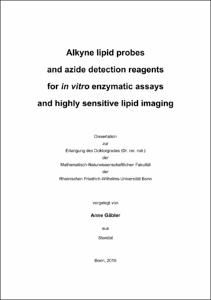Gäbler, Anne: Alkyne lipid probes and azide detection reagents for in vitro enzymatic assays and highly sensitive lipid imaging. - Bonn, 2015. - Dissertation, Rheinische Friedrich-Wilhelms-Universität Bonn.
Online-Ausgabe in bonndoc: https://nbn-resolving.org/urn:nbn:de:hbz:5n-41063
Online-Ausgabe in bonndoc: https://nbn-resolving.org/urn:nbn:de:hbz:5n-41063
@phdthesis{handle:20.500.11811/6526,
urn: https://nbn-resolving.org/urn:nbn:de:hbz:5n-41063,
author = {{Anne Gäbler}},
title = {Alkyne lipid probes and azide detection reagents for in vitro enzymatic assays and highly sensitive lipid imaging},
school = {Rheinische Friedrich-Wilhelms-Universität Bonn},
year = 2015,
month = aug,
note = {Click chemistry has emerged as a powerful tool for the sensitive and specific labeling of biomolecules in various applications. For the design of lipid probes, a small and non-interfering tag is important to prevent substantial influence on the characteristics of the lipid. The copper-catalyzed azide-alkyne cycloaddition (CuAAC) allows the bioorthogonal detection of alkyne lipids with azide bearing reporter molecules.
In vitro enzymatic assays are a major source of information about the properties of enzymes and have so far been carried out mainly with radiolabeled or fluorescent probes. In this thesis, various click chemistry based in vitro enzymatic assays were established and the kinetic characteristics of alkyne lipid substrates were analyzed. All enzymes tested displayed the same affinity to alkyne lipids as to their natural or radiolabeled counterparts. Thus, alkyne lipids are versatile substrates for in vitro enzymatic assays.
The demand to study the intracellular localization of lipids has led to recent progress in microscopy imaging of alkyne lipids. However, their detection is crucially dependent on the appropriate azide detection reagent. It should favor a fast and efficient click reaction and therefore a sensitive detection of the lipids. For this purpose, biotinylated azide reporters with different polyethylene spacer components were synthesized in this study and their suitability for lipid imaging in fixed cells was tested. The introduction of a copper-chelating picolyl moiety strongly increased the signal intensity derived from the alkyne lipids, allowing the highly sensitive imaging of the metabolites of alkyne-oleate, propargylcholine and alkyne-cholesterol.
With the improved protocol, alkyne-cholesterol was detected at the endoplasmic reticulum (ER) and the surface of lipid droplets (LDs) in HuH7 hepatocarcinoma cells. Using stimulated emission depletion (STED) microscopy, alkyne-cholesterol positive membrane contacts between the two organelles were identified. Loading of the HuH7 cells with unlabeled lipids affected the storage of esterified alkyne-cholesterol in LDs. The cholesterol esterification step inside hepatocytes might play an important role in the maintenance of hepatic cholesterol homeostasis and the prevention of hepatocellular lipotoxicity, and will be investigated further.},
url = {https://hdl.handle.net/20.500.11811/6526}
}
urn: https://nbn-resolving.org/urn:nbn:de:hbz:5n-41063,
author = {{Anne Gäbler}},
title = {Alkyne lipid probes and azide detection reagents for in vitro enzymatic assays and highly sensitive lipid imaging},
school = {Rheinische Friedrich-Wilhelms-Universität Bonn},
year = 2015,
month = aug,
note = {Click chemistry has emerged as a powerful tool for the sensitive and specific labeling of biomolecules in various applications. For the design of lipid probes, a small and non-interfering tag is important to prevent substantial influence on the characteristics of the lipid. The copper-catalyzed azide-alkyne cycloaddition (CuAAC) allows the bioorthogonal detection of alkyne lipids with azide bearing reporter molecules.
In vitro enzymatic assays are a major source of information about the properties of enzymes and have so far been carried out mainly with radiolabeled or fluorescent probes. In this thesis, various click chemistry based in vitro enzymatic assays were established and the kinetic characteristics of alkyne lipid substrates were analyzed. All enzymes tested displayed the same affinity to alkyne lipids as to their natural or radiolabeled counterparts. Thus, alkyne lipids are versatile substrates for in vitro enzymatic assays.
The demand to study the intracellular localization of lipids has led to recent progress in microscopy imaging of alkyne lipids. However, their detection is crucially dependent on the appropriate azide detection reagent. It should favor a fast and efficient click reaction and therefore a sensitive detection of the lipids. For this purpose, biotinylated azide reporters with different polyethylene spacer components were synthesized in this study and their suitability for lipid imaging in fixed cells was tested. The introduction of a copper-chelating picolyl moiety strongly increased the signal intensity derived from the alkyne lipids, allowing the highly sensitive imaging of the metabolites of alkyne-oleate, propargylcholine and alkyne-cholesterol.
With the improved protocol, alkyne-cholesterol was detected at the endoplasmic reticulum (ER) and the surface of lipid droplets (LDs) in HuH7 hepatocarcinoma cells. Using stimulated emission depletion (STED) microscopy, alkyne-cholesterol positive membrane contacts between the two organelles were identified. Loading of the HuH7 cells with unlabeled lipids affected the storage of esterified alkyne-cholesterol in LDs. The cholesterol esterification step inside hepatocytes might play an important role in the maintenance of hepatic cholesterol homeostasis and the prevention of hepatocellular lipotoxicity, and will be investigated further.},
url = {https://hdl.handle.net/20.500.11811/6526}
}






